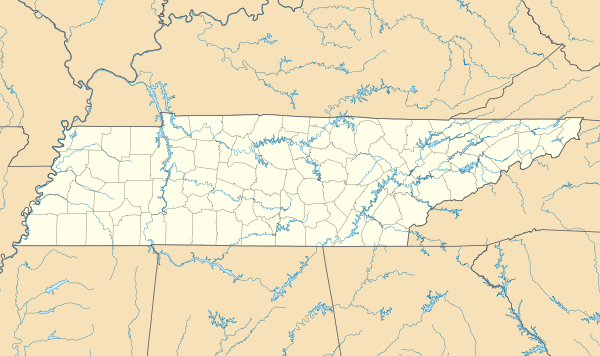Triune, Tennessee
| Triune | |
|---|---|
| Unincorporated community | |
 Triune  Triune | |
| Coordinates: 35°51′15″N 86°39′32″W / 35.85417°N 86.65889°W | |
| Country | United States |
| State | Tennessee |
| Counties | Williamson |
| Elevation | 836 ft (255 m) |
| Time zone | CST (UTC-6) |
| • Summer (DST) | CDT (UTC-5) |
Triune is an unincorporated community in eastern Williamson County, Tennessee, approximately halfway between Franklin and Murfreesboro. The community is located along the Wilson Branch of the Harpeth River and at the intersection of State Route 96 (Murfreesboro Road) and the concurrency of U.S. Routes 31A and 41A (Nolensville Road), just north of their interchange with State Route 840.
History
The earliest recorded non-Native American settlement in the Triune area was by William Jordan, a man from Virginia who built a log cabin in the area in 1796.[1] In the early 1800s, the community, then called Hardeman's Crossroads (or Hardeman Cross Roads) for an early landowner, grew. By the 1820s it included several substantial buildings, including stores, saloons, and leather shops. Several local plantations had their own mills and cotton gins.[1] By 1830, Hardeman's Crossroads had a post office.[1] The community later was called Flemingsburg.[2] The name Triune was derived from the name of the Triune Methodist Church, built in 1849 and the first church building in the community.[2] Triune was the site of five schools built between 1820 and 1845.[2]
During the Civil War, Triune was the scene of several engagements. Several Confederate brigades under General Braxton Bragg were stationed in the area in 1862, and in December 1862 the area was the scene of military activity related to the Battle of Stones River. After Bragg's defeat there, Union Army forces occupied Triune and erected fortifications at the crossroads.[1][3] Between April and June 1863 there were several cavalry skirmishes in Triune, including one in June in which Confederate forces led by Nathan Bedford Forrest succeeded in penetrating Union lines.[1][4] The Methodist and Baptist churches, several homes, and the Porter Female Academy, a girls' school, were destroyed by fire as a result of military action in 1863.[5] As of the 1880s, Triune had 57 residents.[1]
Dr. Jonathan Bostick, a Mississippi plantation owner who had been a trustee of Porter Female Academy and who died in 1868, provided in his will for the establishment of a "suitable site and buildings" for a new "female academy" in Tennessee.[2][5][6] There was a long delay, including extended litigation that reached the U.S. Supreme Court, before his directions could be carried out, but eventually 11 acres (4.5 ha) of land in Triune were purchased for the construction of the Bostick Female Academy, which was built in 1892 and began operation in 1893.[2][5][6] The Bostick Female Academy operated as a girls' boarding and day school, enrolling as many as 75 girls, until about 1900, when the availability of public education eliminated the demand for private schooling.[2][5] After the Hardeman Academy, which had been built in 1828 and was serving as a public school, was destroyed by fire in 1904,[1][2] the Bostick Female Academy building took its place, serving as the Triune public school until the mid-20th century.[7]
Modern Triune is the site of a manufacturing facility that produces equipment for harvesting tobacco.[8]
Landmark buildings

The Bostick Female Academy building is now a private residence[2] and was listed on the National Register of Historic Places in 1982.[1] The Triune Methodist Church, built in 1874 on the foundation of the church's original building, is another 19th century landmark building in Triune.[2] Several homes built in the early 19th century were also still standing as of 1988.[1]
A more recent local landmark is Castle Gwynn, a replica of a 12th-century Welsh border castle. It was built as private residence beginning in 1980 and serves as the location of the Tennessee Renaissance Festival, a Renaissance fair held annually in May.[9]
References
- 1 2 3 4 5 6 7 8 9 Thomason Associates and Tennessee Historical Commission (February 1988). "Historic Resources of Williamson County (Partial Inventory of Historic and Architectural Properties), National Register of Historic Places Inventory Nomination" (PDF). National Park Service.
- 1 2 3 4 5 6 7 8 9 Robert S. Brandt (1995), Touring the Middle Tennessee backroads, page 180. John F. Blair, Publisher. ISBN 0-89587-129-7, ISBN 978-0-89587-129-9.
- ↑ THE WAR IN TENNESSEE.; The Positions of the Opposing Forces. General Rosecrans Massing His Forces at Murfreesboro. CONSTANT SKIRMISHING AT THE OUTPOSTS. New York Times, March 29, 1863
- ↑ THE WAR IN TENNESSEE.; ANOTHER FIGHT AT TRIUNE THE REBELS REPULSED. National Soldiers to be Executed for Desertion., New York Times, June 14, 1863.
- 1 2 3 4 Bostick Female Academy historical marker, Edge of the Wildwood website, August 23, 2010
- 1 2 U.S. Supreme Court, Peters v. Bowman, 98 U.S. 56, 25 L.Ed. 91. October term 1878.
- ↑ Brandt (1995) states that the building was used as a public school until 1957, but the historical marker on the property gives a date of 1949.
- ↑ John E. Acuff (2009), Williamson County, Tennessee Encyclopedia of History and Culture.
- ↑ Jessica Muzo, "The Story Behind Castle Gwynn is a Labor of Love", Tennessee Home and Farm, March 1, 2007
Gallery
 Topographical sketch with Triune and vicinity circa 1861-1865.
Topographical sketch with Triune and vicinity circa 1861-1865.